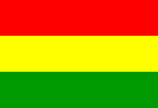![[raised detail]](../images/v/vxt-d1424.jpg)
Padded Emblem/Raised Detail on the Flag of San Cristóbal de la Laguna, Tenerife, Spain (Klaus-Michael Schneider)
![[pale]](../images/v/vxt-d5182.gif)
![[pale]](../images/v/vxt-d3949.gif)
![[pale]](../images/v/vxt-d977.gif)
War Flag of Peru;
Flag of Harbarnsen, Germany;
Flag of Hoogstraten, Belgium
2) In some heraldic usage this term relates specifically to the axis of a charge or charges, rather than to its, or their position, on a shield, a banner of arms or a flag – but see ‘in pale’ as referenced above and the note below.
![[palewise example]](../images/v/vxt-d4593.gif)
![[palewise example]](../images/v/vxt-d3950.gif)
![[palewise example]](../images/v/vxt-d2902.gif)
Flag of Villars-sous-Mont, Switzerland;
Flag of Duffel, Belgium; Flag of Rudolfstetten-Friedlisberg,
Switzerland
Please note with regard to 2) that charges can be orientated palewise but arranged in fess as per the examples shown below which would be blazoned "... three saw blades palewise in fess".
![[palewise example]](../images/v/vxt-d3951.gif)
![[Vaksdal, NO]](../images/v/vxt-d3951a.gif)
Flag and Arms of Gjerstad, Norway
![[flags with pall]](../images/v/vxt-d3729.gif)
![[flags with pall]](../images/v/vxt-d231c.gif)
![[flags with pall]](../images/v/vxt-d4826.gif)
Flag of Horní Jiřetín, Czechia;
Flag of the Archbishop of Canterbury, UK;
Flag of Santo António da Serra, Portugal
Notes
a)
With regard to 1) when the two arms of the "Y" are on the hoist it may be called a simple pall,
with the two arms on or towards the fly a reversed pall, with the two arms on the top edge an upright
pall and with the two arms on the bottom edge of the flag an inverted pall – see
inverted, reversed and
upright.
b) The pall design originated as the pallium, a vestment symbolic of Arch-episcopal authority in some Christian churches
(see also pallia).
Please note, not to be confused with a pall as defined above.
![[flags with pall]](../images/v/vxt-d3731a.gif)
![[flags with pall]](../images/v/vxt-d3731.gif)
Arms and Flag of Kvinnherad, Norway
![[pallia]](../images/v/vxt-d233.gif)
One interpretation of the Pallia given to William
of Normandy in 1066 as shown in the Bayeux Tapestry, and the earliest known representation
of a gonfanon.
Notes
a) This term was derived from an item of
arch-episcopal regalia – the pallium – and was almost certainly in the majority of cases a
gonfanon.
b) "Pallia" and "pallium" are (respectively) the plural and singular in Vulgate Latin.
![[pallet]](../images/v/vxt-d1725.gif)
![[pallet]](../images/v/vxt-d4828.gif)
![[pallet]](../images/v/vxt-d4827.gif)
Flag of Commugny, Switzerland;
Flag of Foix, France; Flag of Vila Boa de Ousilhão,
Portugal
![[pallet wavy]](../images/v/vxt-d4829.gif)
Flag of Albergaria da Serra, Portugal
![[paly]](../images/v/vxt-d4830.gif)
![[Wisen, Switzerland]](../images/v/vxt-d2787.gif)
![[Arrissoules, Switzerland]](../images/v/vxt-d979.gif)
Flag of Rovray, Switzerland;
Flag of Leipzig, Germany;
Flag of Arrissoules, Switzerland

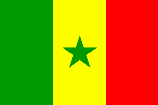

The National Flag of
Ghana; The National Flag of Senegal;
National Flag of Benin
Notes
a) Some sources include the Garvey and
Rastafarian colours (as referenced above) in this category.
b) Flags that share the same colours, but which do not have the historic or geographic connections given above (for example the flag of Bolivia illustrated below) must not be included in this category.


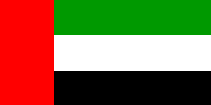
National Flag of Jordan;
National Flag of Sudan;
National Flag of the United Arab Emirates
Notes
a) The lines mentioned in the
definition read: “White are our deeds, black the fields of battle, our
pastures are green, but our swords are red with the blood of our enemy.” and
the first flag to used these colours was the Arab Liberation Flag of 1917
(as mentioned above).
b) The red, white and black (with or without a touch of green) introduced
by Egypt in their tricolour of 1958 are included by some sources in the above
category – but see ‘Arab liberation colours’.
c) It should be further noted that flags which share the same colours, but which do not have
the historic or geographic connections given above (for example the flag of
Malawi
illustrated below) must not be included in this category.
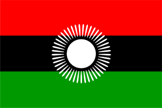
National Flag of
Malawi 2010–2012
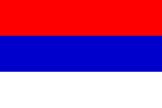

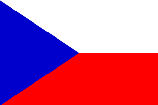
The National Flag of
Serbia 1882–1918; National Flag of Slovakia; Flag of
Czechia
a) The red-white-blue tricolour of the Netherlands was almost certainly the model upon which the Russian flag (adopted as a civil ensign c1700) was based, and that some sources include these same “Dutch colours” in the above category – but see ‘Dutch colours 1)’ (also ‘driekleur’ and ‘princeflag’).
b) Flags that share the same colours, but which do not have the historic or geographic connections given above (for example the flag of France illustrated below) must not be included in this category.
2) In heraldry see ‘quarter 2)’.
![[panel example]](../images/v/vxt-d2018.gif)
![[panel example]](../images/v/vxt-d5183.gif)
Flag of Guam;
Flag of Oldenburg County, Germany
![[panicles example]](../images/v/vxt-d508a.gif)
![[panicles example]](../images/v/vxt-d508b.gif)
![[panicles example]](../images/v/vxt-d508c.gif)
Flags of a General, Lt
General and
Major General, Taiwan
![[PMS example]](../images/v/vxt-d5184.gif)
![[PMS example]](../images/v/vxt-d5185.gif)
![[PMS example]](../images/v/vxt-d3850.gif)
Flag of the Lomé Convention in Green PMS 3415C, Gold PMS 131C and Process Blue C;
Flag of Santa Clara County, California US in Blue PM PMS 2925 and Gold PMS 131;
National Flag of Argentina in Blue PMS 284, Yellow PMS 1235 and Brown PMS 1685

![[pageant standard]](../images/v/vxt-d1494.gif)

![[illustration of a palm]](../images/v/vxt-d234.gif)
